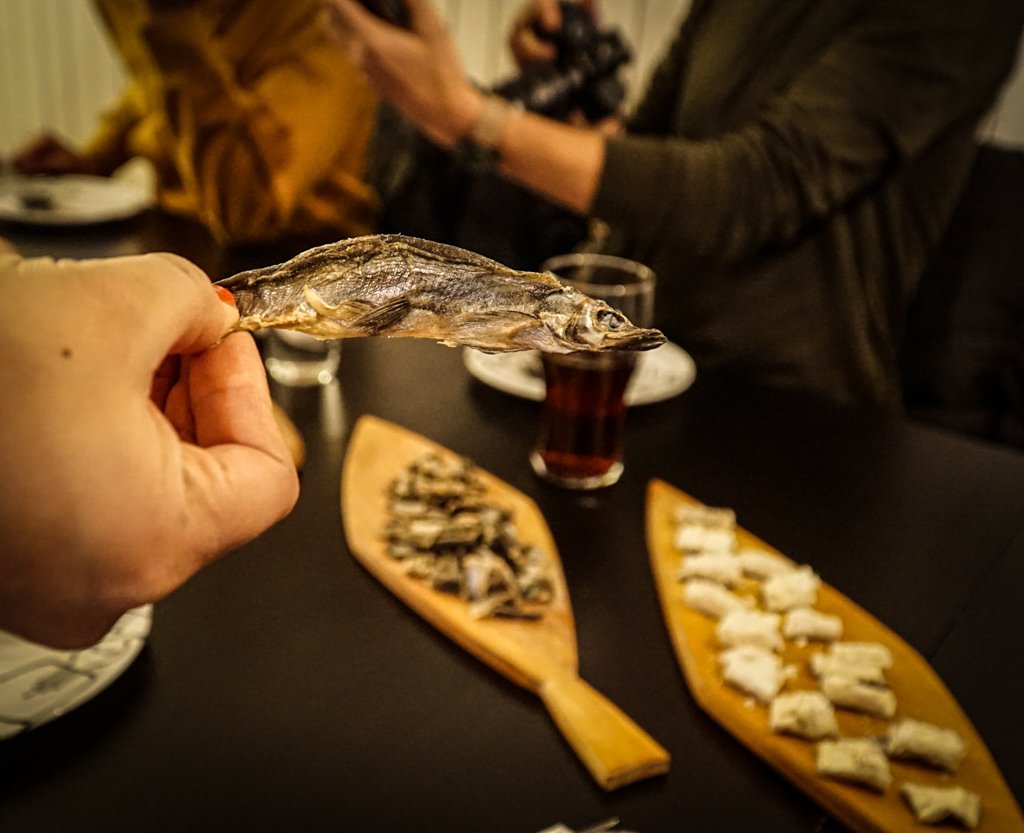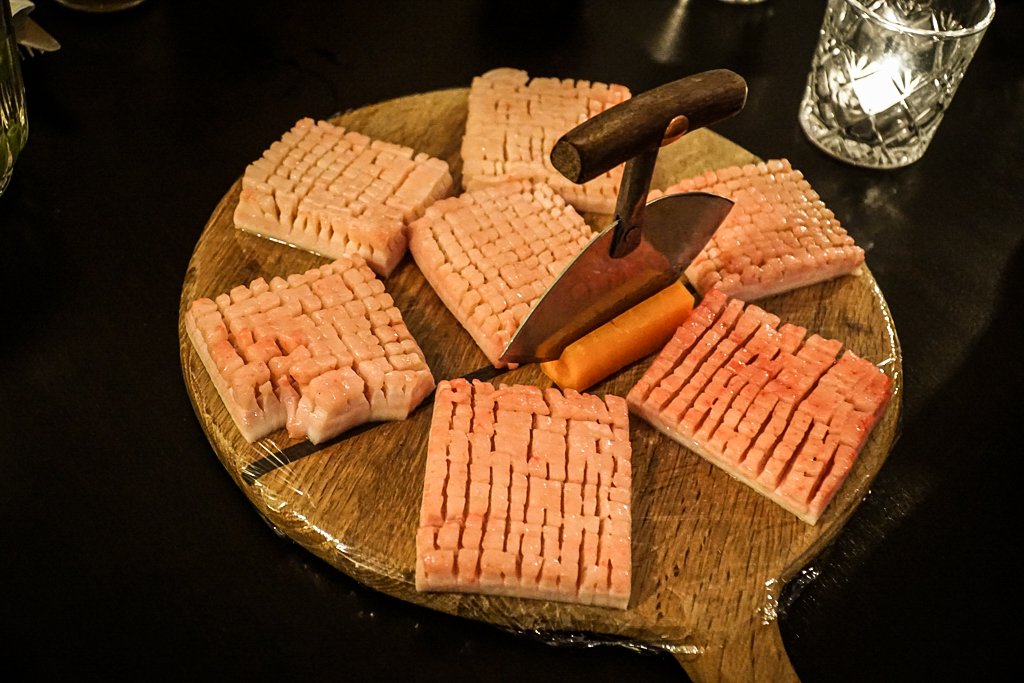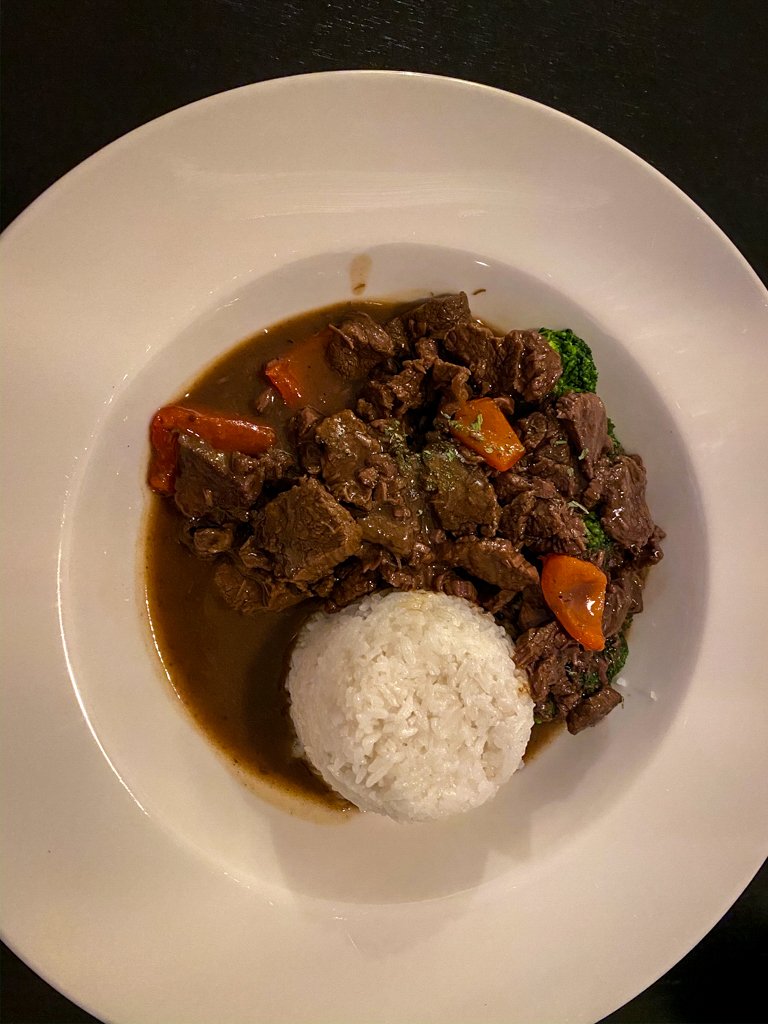Living Off the Land in Greenland
Text and photos by Natasha Amar
Ammassat, or dried capelin, a small shiny, silvery fish, is eaten as a snack around the country. Drying and preservation of meat and fish are ingrained in the Inuit culinary tradition, understandably from the old days, when these methods ensured that the larder was stocked up for the long, cold winters.
I’ve barely just met him earlier in the day, but it takes only a minute to see that Salik Hard, one of my hosts in Nuuk, the capital of Greenland that lies 240 km south of the Arctic Circle, is a gifted storyteller. His eloquence lies not just in his words, carefully chosen for the greatest impact, but also in the many emotions that flicker across his face momentarily when he is telling a story—especially if that story is about food.
An eyebrow raised ever so slightly, a pause, uncertain and prolonged, a laugh, unrestrained and warm as a steaming bowl of soup on a winter night. There’s wit, humor, suspense, nostalgia, and almost always, pride, when he speaks of Inuit culture in Greenland.
Senior project manager at the Sermersooq Business Council, he is kindly hosting our dinner party of seven at Café Inuk in Nuuk, Greenland’s only official city.
Having hurriedly entered the café to escape winds that had chilled us to the bones, we’re now all visibly relaxed in its warmth, coats, scarves, and hats hanging by the door.
At the entrance, the off-white hide of a polar bear lies sprawled over a wooden bench under the soft light of a pendant lamp. At this moment, my mind begins to comprehend how massive polar bears, the world’s largest land predators, can be. Instinctively, I walk past the bench, running my fingers on the hide, and sit on a wooden chair so I can tie my laces that have now come undone from stomping in the snow outside.
The Indigenous Inuit people have been sustainably hunting polar bears for thousands of years. But large-scale, unregulated hunting by European, Russian and North American hunters from the 1700s to the 1970s resulted in polar bears becoming an endangered species, according to the World Wildlife Fund. Today, the Inuit are allowed to hunt polar bears for subsistence, and commercial hunting of polar bears is banned.
Maren-Louise P. Kristensen’s darkly lined eyes shine with the same passion for Greenlandic culture as Hard’s. Together with Liisi Egede Hegelund, she is the co-owner of Cafe Inuk and Inuk Hostels, a group of colorful timber cabins at the edge of the fjord.
She has invited us to learn about Inuit culture through its food. She is keen to introduce us not only to traditional foods that have helped the Inuit people survive the harsh conditions of the Arctic, but also to modern-day influences that represent how the cuisine has adapted and evolved in a globalized world.
A few minutes later, our dinner table is full of meat; most of the flavors and textures are new to me. There’s mattak, or raw narwhal blubber, orange-pink, the whale hide is cut into bite-sized pieces. An ulu, a big, beautiful, and undoubtedly sharp knife with a wooden handle stands in the center of the board, to cut through the tough fatty skin.
“Try it with some salt and soy sauce,” Maren-Louise says.
Although soy sauce is relatively new to Greenland, it’s become common on mattak. I follow Hard’s lead and help myself to a piece, not knowing what to expect. The blubber is tough and takes time to chew. I wonder if it could be the limited experience of my palate. I look around to see the other faces on the table, mouths chewing intently.
“Mattak is a delicacy in our culture,” says Hard as he helps himself to more, “It’s rich in vitamin C. A must in our diet, something we love.”
Growing up to a length of 5 meters, the narwhal’s most distinguishing feature is its 2- to 3-meter-long spiral tusk. Found in the male of the species, it is not unlike that of the mythical unicorn, earning it the nickname “unicorn of the sea”. Its average age? Well over a hundred years.
For a city-dweller like me, accustomed to her neighborhood supermarket shelves in Dubai being stocked with Peruvian avocados, Dutch tomatoes and Norwegian salmon, this is something of an adventure.
For the Inuit in Greenland, at home in a land that is for the most part covered by the glacial ice of the Greenland Ice Sheet, and where most agricultural produce comes from neighboring Denmark, this is everyday food in a diet that has been shaped by a need for survival.
Birds and marine and land mammals such as narwhal, seal, walrus, polar bear, musk ox and reindeer are all commonly found on dinner tables across the country, simply because these are the sources of protein that have been most accessible throughout history.
This, I remind myself, is a country where roads do not connect cities, towns and regions; propeller planes and ferries are used to transport produce and people, and schedules operate strictly according to weather conditions. My own journey to Nuuk included a flight by propeller plane from Kangerlussuaq, a town that served as a U.S. airbase during WWII and today offers international flight connections to Copenhagen.
The Thule people first came to these shores thousands of years ago with their kayaks, harpoons and sled dogs. Their descendants are the Inuit who are still here today.
In fact, a visit to the Greenland National Museum earlier in the day made clear that it was the Inuit who built and perfected the qajaq or kayak, as it’s commonly known today.
Today, sustainability guidelines govern which animals can be hunted and to what extent.
While the Inuit are exempt from international whale-hunting bans, they have to adhere to hunting limits that ensure that whale populations are maintained at healthy levels. They are allowed to hunt whales for subsistence and to make and sell traditional handicrafts, but the export of whale and seal meat is prohibited.
Mattak, or raw narwhal blubber, is cut into bite-sized pieces. An ulu, a big, beautiful, and undoubtedly sharp knife with a wooden handle stands in the center of the board, to cut through the tough fatty skin.
But halibut? That’s a whole other story. Halibut fishing is a year-round occupation in Greenland for both Inuit and migrant workers, and a lucrative one at that. Fishing accounts for 90 percent of Greenland’s exports. In a few days, I’ll hear the term, “Halibut money” in the town of Ilulissat, used to describe the fortunes of fishermen who go ice-fishing in the icefjord, and make a hole in the ice using a tooq, a tool used by hunters to catch Greenland halibut.
More than 250 kinds of fish thrive in the country’s cold, clear waters. Atlantic salmon, Arctic char, cod, redfish, and Greenland halibut are just some of the species you can expect to sample when in Greenland, along with prawns, crabs and mussels.
While, traditionally, hunters used dog sleds in the winter and kayaks in the summer to go hunting, this has changed with modernization coupled with the challenges presented by climate change and the melting sea ice. Today, snowmobiles and motorized boats are also used.
“Hunting and gathering are a very important part of my culture,” Hard says. “If you take that away from me, it’s like taking away one of my limbs.
I help myself to ammassat, or dried capelin, a small shiny, silvery fish, and panertoq, or salted and dried cod, both also eaten as snacks around the country. Drying and preservation of meat and fish are ingrained in the Inuit culinary tradition, understandably from the old days, when these methods ensured that the larder was stocked up for the long, cold winters. Raw and smoked meat also feature widely in the diet.
When the main course arrives, I’m not surprised by the meat. Reindeer is an important part of the diet in the Arctic and has been of cultural importance to the indigenous people that live here. It was in Sapmi, the land of the Sami people, that I had my first sighting and first taste in Sweden, a few years ago.
“Our lives,” says Hard, “are dependent on reindeer and reindeer hunting.”
But this comes with a surprise: The rich reindeer stew before me, served with rice, is fragrant with an aroma that I associate with Thai cuisine. Modern Greenlandic cuisine, as Maren-Louise explains, marries traditional ingredients from Inuit cuisine with flavors brought to the country by immigrants. The great majority come from Denmark, but clearly some are from farther afield. The Danish influence on the cuisine is apparent, especially when eating out at restaurants and cafés in Nuuk.
The stew packs a punch and the spice-loving Indian in me relishes the heat of a particular spice I can taste, but can’t quite pinpoint. It’s new but comfortingly familiar, just like every trip to the Arctic, for which a profound love simmers in my heart, patient but persistent, the entire time I’m away.
The conversation has turned to polar bears, of which 22,000-31,000 remain in the world today, according to WWF. Inuit guide Aviaja Kristiansen is telling us what it was like to grow up in the town of Tasiilaq in East Greenland, where polar bear sightings aren’t uncommon.
While polar bears are inclined to stay on the sea ice, feeding on ringed and bearded seals, climate change and the resulting thinning of sea ice means that they venture onto shore more often than they used to.
She recounts a time in her childhood when she received a call from her mother to warn her from leaving the house because a polar bear was seen outside, and spotted it just outside her window.
Both Hard and Kristiansen believe that a meat-heavy diet has helped the Inuit survive in Greenland. Kristiansen is telling us about eating seal liver, the warmth of which persists in one’s body even in the coldest of conditions. Like reindeer and whale, the Inuit have been eating seal meat, more commonly ringed, harp and hooded seal, for thousands of years. Greenland’s national dish is suaasat, a broth of seal meat cooked with onions and barley or rice.
Rich reindeer stew, served with rice, is fragrant with an aroma that I associate with Thai cuisine. Modern Greenlandic cuisine, as Maren-Louise explains, marries traditional ingredients from Inuit cuisine with flavors brought to the country by immigrants.
I think about the Inuit legend of Sedna, the Mother of the Sea, a story Hard told me earlier today. The legend says that when hunters and fishermen in the settlements got too greedy and took more than what they needed, the Mother of the Sea trapped the fish, seals, whales and other mammals in her long hair, to teach them a lesson. Desperate from starvation, the people sent a shaman who, after some negotiation, combed her hair and set the animals free, making food available to hunters and fishermen again. The lesson? Respect nature and her bounty; take only what you need.
All parts of the animals that are hunted are utilized in some way. Other than food, they’re used in clothing, footwear, tools, handicrafts, or even transportation. Take for example seal skin: dyed, it is used in the colorful national dress, while seal fur is used to make clothing that protects hunters from extreme temperatures when they’re out on the sea ice. When a culture develops in a place where the forces of nature reign supreme, there is, often, no taking for granted, no wastage and no room for elitism in food.
A traditional Inuit meal in Greenland is a lesson in cultural heritage that draws from the realities of lives lived in such extreme conditions.
But my own lesson in the cuisine of Greenland is far from complete. I learn, on my second night in Nuuk, that there is still room for creativity. In fact, when I dine at the modern Restaurant Sarfalik at Hotel Hans Egede, where we’re staying, the next night, I realize it is quite the contrary.
First, there are more courses than I can keep count of, that appear at the table, barely a minute after I manage to finish each one. While the ingredients may be those that feature traditionally in Inuit cuisine, such as musk ox and Greenland halibut, the preparation is innovative and the presentation, elaborate. There’s snow crab with ice wine, fennel, and parmesan, Greenland halibut sashimi with pickled shitake, and musk ox tartare, which is a first for me.
The musk ox, or umimmak in Greenlandic, is the largest land mammal in Greenland, and the male of the species can weigh up to a whopping 400 kilograms. Thick, luxurious musk ox fur, with its warm wool called qiviut is used in local clothing and can keep the human body warm at temperatures below -45 degrees Celsius. The next day, I discover in a local boutique in Nuuk, that it is, understandably, also quite expensive.
I’m way past the point of being stuffed, but soon enough, I find myself reaching out for a taste of Narsaq lamb, a local specialty, served with Jerusalem artichokes and leeks, and it’s worth it.
The lamb is from Narsaq, an agricultural town of 1,500 residents in South Greenland that is known for sheep farming and local produce such as turnips, potatoes, carrots, lettuce and strawberries. Greenlandic lamb is considered among the best in the world, thanks to free-roaming sheep that feed on grass, plants and herbs in the region’s lush meadows, and drink from clear, mineral-rich waters.
In the days to come, I will venture 250 kilometers north of the Arctic Circle to Ilulissat, where I’ll find myself enjoying other meals―cod and Greenland halibut at the edge of the Ilulissat Icefjord and the simple comfort of steaming reindeer broth, just before the Aurora Borealis illuminates the night sky over a solitary igloo lodge set in a frozen winter wonderland.
But tonight, I look out the window of the restaurant, and it is a face across the street that captures my attention. A big painted mural on a building features an Inuit hunter, his smile seeps into the lines around his eyes. I smile back, and savor every last morsel, warm and tender, of Greenland on my plate.



